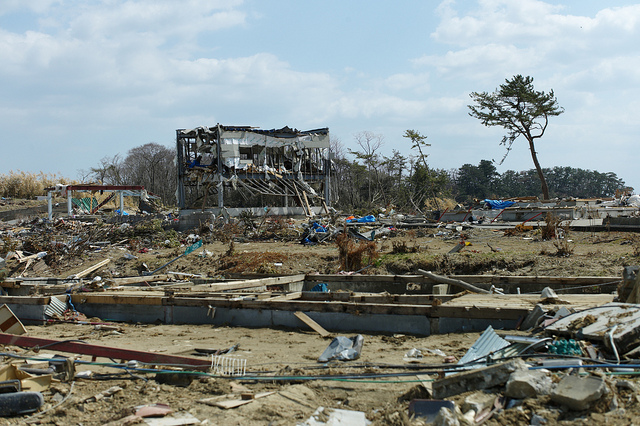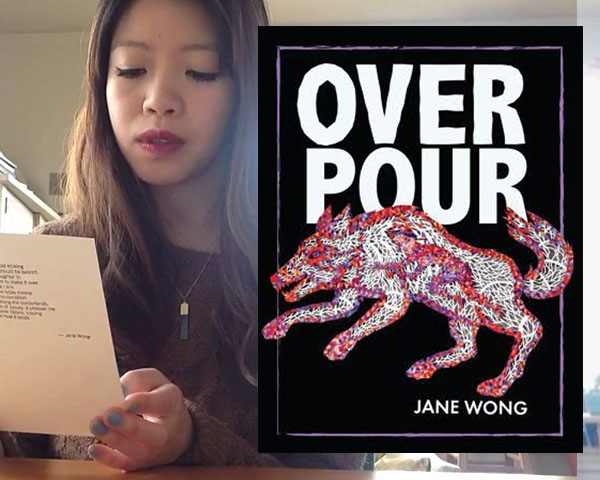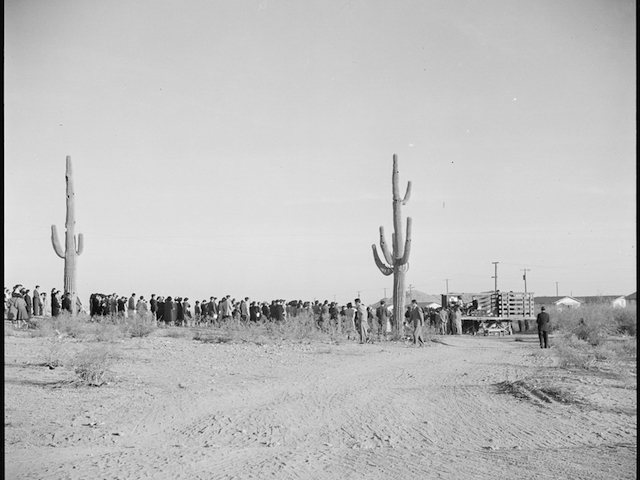Poet and journalist Luis H. Francia journeys through Japan, bearing witness to the devastation wrought by the 2011 earthquake and tsunami—and to the creativity arising from these very areas.

August 14, 2012
It seemed clear to everyone that such a tradition had to be reimagined if it were to appeal to the young. Kaihatsu, our artist friend, had in the past recommended experimenting with jazz as the accompanying music for the dance. I thought (though being an onlooker, I left it unsaid), that they had to include women in the discussion, and encourage them to learn the lion dance. Jazz, women: these would surely have a radical effect on the kagura, and, in the minds of the traditionalists at the meeting, were probably about as welcome as a tsunami. Nevertheless, the very fact that the topic was the continuation of a tradition was a hopeful sign that these villagers were no longer as obsessed with physical survival, as they once must have been.
—

In Minamisoma, Kaihatsu had created an installation: a one-room, one-window shack that faced in the direction of the Fukushima plant twenty kilometers away, operated by TEPCO (Tokyo Energy Power Company). Inside, the only piece of furniture was a chair facing the window. Kaihatsu had dubbed it “the politicians’ house,” where a pol could sit in the chair and contemplate the folly and tragedy of March 11. He had invited all 700 members of the Japanese parliament, including the prime minister. Only two had expressed any interest. None had shown up.
Kaihatsu wanted me to inscribe something right at the entrance, a poem perhaps, but the best I could manage was “Power to the People, Not People to the Power!” The slogan from the John Lennon/Plastic Ono Band song seemed appropriate in light of the current debate (or the debate about current) over the fate of nuclear power in Japan. TEPCO’s pussyfooting around the gravity of the meltdown, in which the government was complicit, revealed that its officials had placed—surprise, surprise—its profit margins above concerns for public health and safety. As we drove around, Kaihatsu had pointed out civic buildings funded by monies from TEPCO, to help convince the local apparatchiks that nuclear power was benign.
The question of nuclear power of course is interwoven with the political and social power structure of the state. Who wields the power that controls the power? As in the United States, the energy lobby in Japan has lots of cash and its reach is tremendous. But power, whether nuclear or political, if unfettered, can and will wreak havoc. The proof was all around us. But this wasn’t the only reason the issue was uppermost in my mind. I had just been to Beijing (my first visit) to attend a conference on Asian-American literature, co-sponsored by the Beijing Foreign Studies University and University of California at Berkeley, and had gotten some inkling of the power of the Chinese Communist Party and its ruling politburo: access to Facebook and YouTube was blocked; Google-ing such topics as Tiananmen, Falun Gong, and the Cultural Revolution somehow always caused the server to be reset. The roseate portrait of a smiling Mao that dominates the portals to the Forbidden City and gazes out at Tiananmen Square is perhaps the most obvious symbol of the Communist Party’s continuing dominance. What the Chairman would have thought of the intense capitalistic fever raging in China we’ll never know—though we can make an educated guess.
You couldn’t just walk into the square; entry was permitted only at designated points, where security was extra tight: the twenty-third anniversary of the June 4, 1989 massacre had occurred only three days before. Yong Soon Min, an artist friend also attending the conference, and I tried to picture where the anonymous individual bravely attempting to bar a tank from moving forward had stood—the iconic photo the world remembers from that day—but of course nothing marked the spot. I wondered if the crowds of mostly local tourists ever thought about how the student-led democracy movement had been crushed, or even if they, especially the younger ones, knew about it. If innocent citizens are felled in the middle of a forest, and there are no accounts of it, did such a massacre really happen?
At the National Museum of China, on the eastern side of the Square—after a thorough pat-down by the black-clad ninja-lookalikes of the Anti-Explosion Security Unit, and a request for me to please take a sip from my water bottle—Yong Soon and I visited the “Road to Rejuvenation,” a presentation of the country’s history from the Opium Wars to the glories of the contemporary era. All the dramatic highlights appeared: the overthrow of the Qin Dynasty in 1911, Sun Yat-Sen and the failure of the first republic, the emergence of the Kuomintang and the Communist Party, the occupation of Manchuria by the Japanese, the ensuing resistance and reluctant coalition between Chiang and Mao, its dissolution and the ensuing civil war, the triumph of Mao (with the Long March given considerable space), the founding of the People’s Republic of China, and so on.
What’s notable, as in any state-sanctioned history, were the omissions: We didn’t see anything on the Cultural Revolution or, for that matter, on the disastrous Great Leap Forward. Jiang Qing, Mao’s widow, and her Gang of Four, didn’t exist. Nor did the Tiananmen massacre. These were some of the more obvious desaparecidos, casualties of deliberate historical amnesia; in fact, the absences resonated more strongly than had these historical events been (even perfunctorily) mentioned.
The Politburo occupies a roughly analogous position to the management of a power plant: through its “good” graces, some power flows to the people, reflecting the top-down approach that betrays, still, a Confucianist sense of hierarchy. Its very successes—and they are formidable—have raised the level of expectations among the country’s billion-plus citizens. Like consumers and as consumers, the Chinese will require that more power flow to them and, at some point, demand a greater say in how the power plant is managed. This was what Tiananmen was about. The memory of 1989 may have been suppressed, but in the interim, the underlying sentiments have only grown, not coincidentally, along with income inequality. If the Politburo wishes to avoid a meltdown, it will need not only to take these sentiments seriously—in a sense, it already does, if only to stifle them—but to let such sentiments shape a republic that is truly the people’s. What is the alternative? Another Arab Spring, surely, and it won’t be a dinner party.
Will China’s leaders be caught by what they have caught? I predict by mid-century they will.



